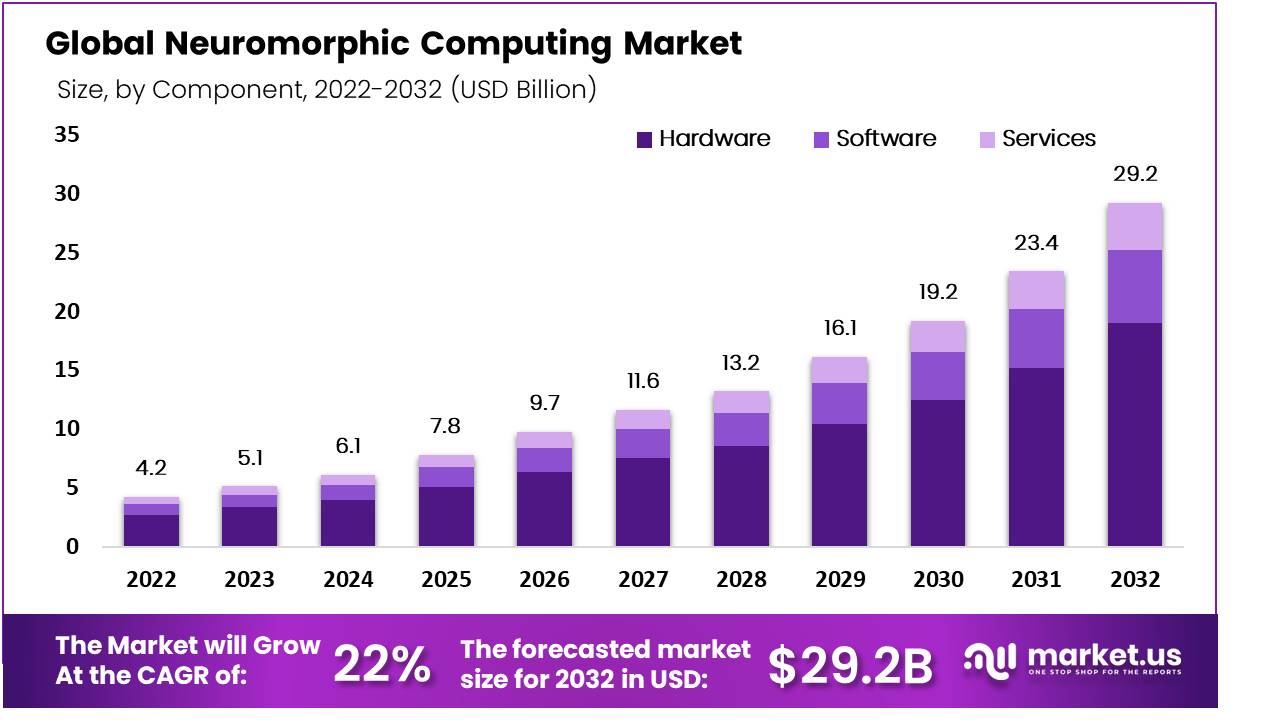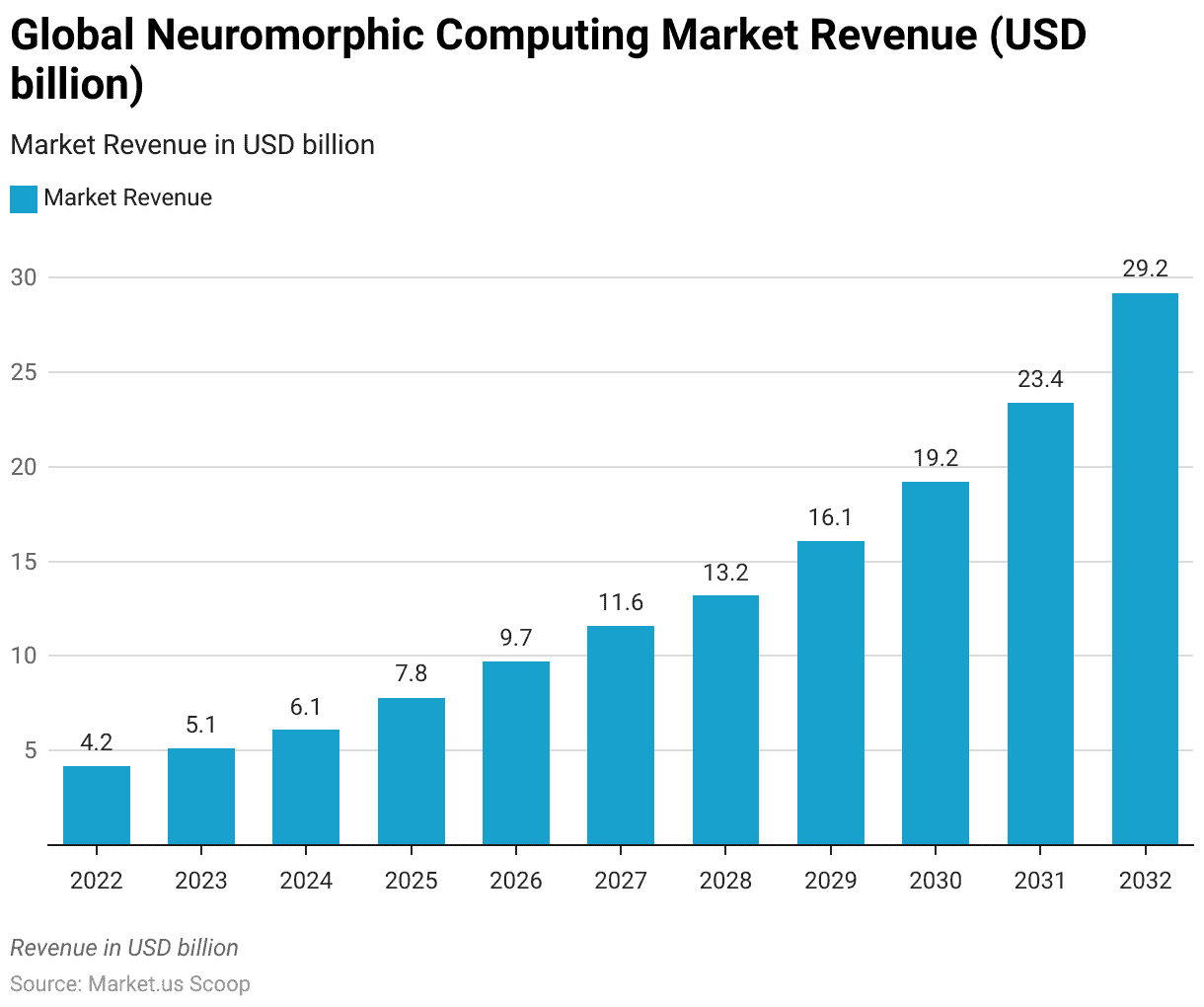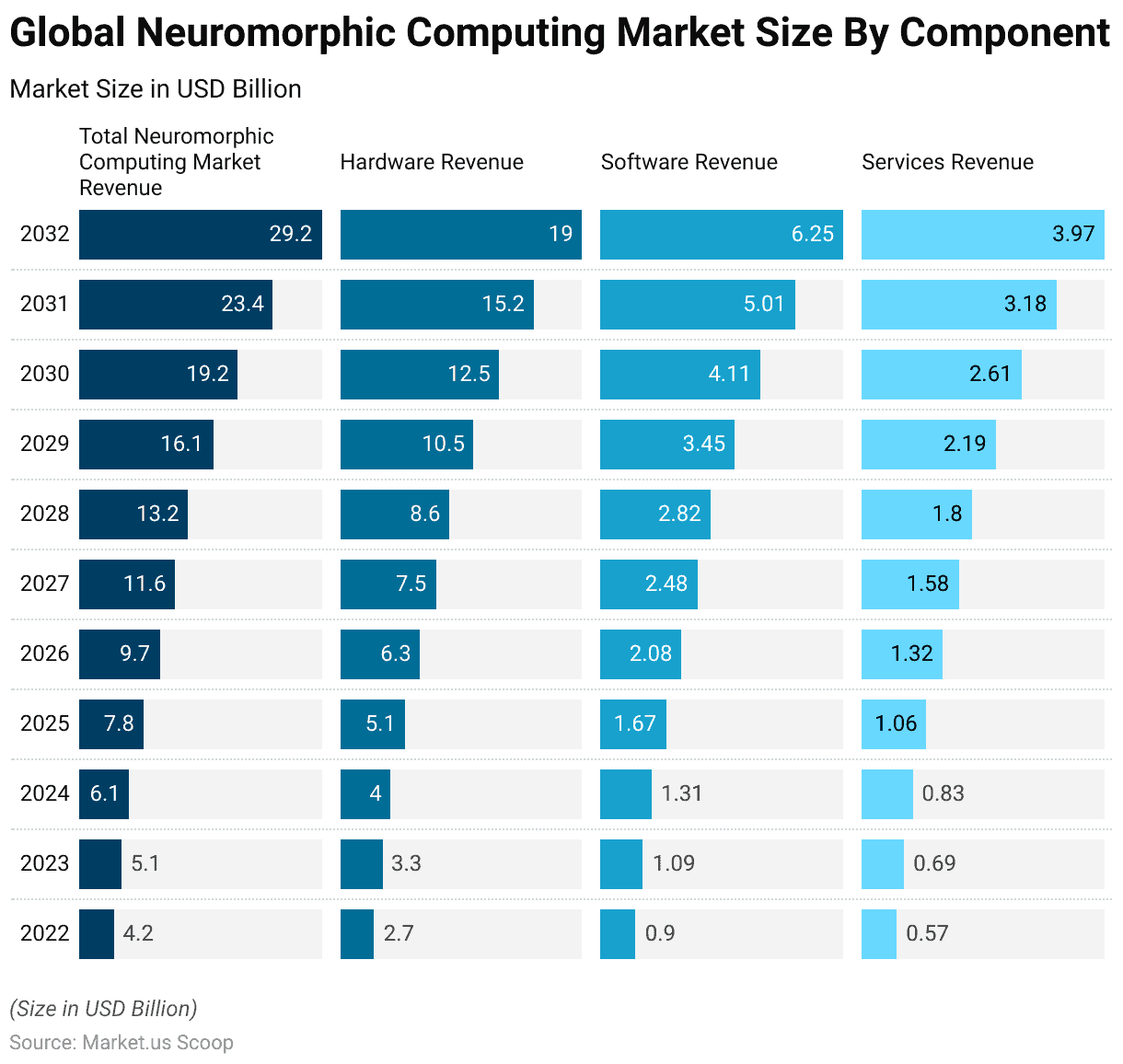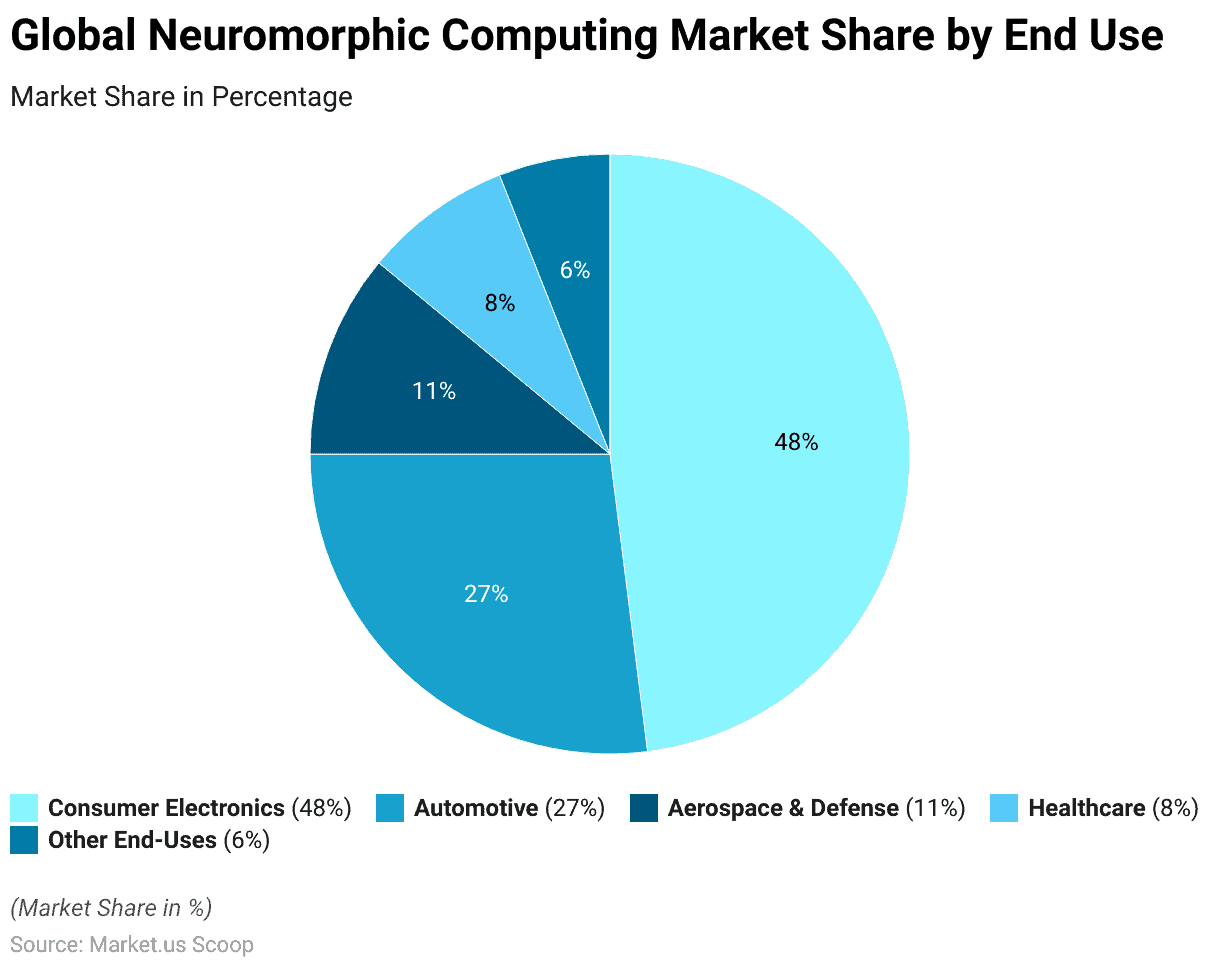Table of Contents
- Introduction
- Editor’s Choice
- Neuromorphic Computing Market Statistics
- Capacity of Some Recent Neuromorphic Systems
- Neural Networks Digital Hardware Implementations
- Recent Neuromorphic Device Implementations
- Materials Systems for Neuromorphic Applications
- Development of Neuromorphic Chips Computing Statistics
- Recent Developments in Neuromorphic Computing Statistics
- Recent Developments
- Conclusion
- FAQs
Introduction
Neuromorphic Computing Statistics: Neuromorphic computing is inspired by the structure and operations of the human brain.
It aims to develop computational systems that can efficiently tackle complex tasks while consuming minimal power.
It entails replicating the brain’s neural networks through technologies like spiking neural networks (SNNs) and memristors.
Which imitates synaptic connections and signaling processes. With applications spanning edge computing, pattern recognition, and robotics, neuromorphic computing offers advantages such as energy efficiency and flexibility.
Despite encountering hurdles like scalability and hardware limitations. It shows significant potential for creating intelligent systems inspired by the brain’s extraordinary capabilities.

Editor’s Choice
- The global neuromorphic computing market accounted for a revenue of 5.1 billion USD in 2023.
- By 2032, the market had expanded significantly, reaching a total revenue of 29.2 billion USD, with hardware accounting for 19.0 billion USD, software for 6.25 billion USD, and services for 3.97 billion USD.
- Consumer electronics dominate the landscape with a substantial market share of 48%. Reflecting the widespread integration of neuromorphic technologies in devices and gadgets to enhance user experience and functionality.
- DYNAPs offer 256 neurons per core and 16K synapses per core. While BrainScaleS provides 512 neurons per core and 128K synapses per core, with four chips per board.
- Among slice architectures, devices like Microdevices MD-1220a, NeuraLogix NLX-420a, and Philips Lneuro-1 offer feedforward and machine-learning capabilities with varying precision, neurons, synapses, and processing speeds.
- In 2016, researchers at MIT introduced a novel chip tailored for neural network implementation. With efficiency levels tenfold greater than a mobile GPU. The chip has the potential to empower mobile devices to execute AI algorithms locally. Eliminating the need to transmit data to the cloud for processing.
- In December 2022, Intel introduced its AI neuromorphic technology. Which offers processing speeds 1,000 times faster than conventional CPUs and GPUs, with notably lower energy consumption.

Neuromorphic Computing Market Statistics
Global Neuromorphic Computing Market Size Statistics
- The global neuromorphic computing market has consistently grown over the past decade at a CAGR of 22%, with revenues steadily increasing from 4.2 billion USD in 2022 to an estimated 29.2 billion USD by 2032.
- This trajectory reflects a compound annual growth rate indicative of the market’s resilience and expanding demand.
- Notably, the sector experienced notable year-on-year gains, with revenues climbing to 5.1 billion USD in 2023. Followed by subsequent increases to 6.1 billion USD in 2024, 7.8 billion USD in 2025, and 9.7 billion USD in 2026.
- By 2027, revenues reached 11.6 billion USD, marking a significant milestone in the market’s progression.
- The upward trend continued in subsequent years, with revenues surging to 13.2 billion USD in 2028, 16.1 billion USD in 2029, and 19.2 billion USD in 2030.
- As the decade unfolded, the market witnessed robust expansion. Culminating in revenues exceeding 23.4 billion USD in 2031 and a substantial 29.2 billion USD by 2032.
- This consistent growth underscores the increasing adoption of neuromorphic computing technologies across various industries. Driven by advancements in artificial intelligence, machine learning, and computational neuroscience.
(Source: Market.us)

Global Neuromorphic Computing Market Size – By Component Statistics
- The global neuromorphic computing market exhibits a multifaceted landscape delineated by its various components – hardware, software, and services.
- From 2022 to 2032, the market has grown substantially across all segments for a decade. In 2022, the total market revenue stood at 4.2 billion USD, with hardware contributing 2.7 billion USD, software 0.90 billion USD, and services 0.57 billion USD.
- This trend of ascending revenue continued through subsequent years, with 2023 recording a total market revenue of 5.1 billion USD. Comprising 3.3 billion USD from hardware, 1.09 billion USD from software, and 0.69 billion USD from services.
- By 2032, the market had expanded significantly, reaching a total revenue of 29.2 billion USD, with hardware accounting for 19.0 billion USD, software for 6.25 billion USD, and services for 3.97 billion USD.
- Such growth underscores the global escalating demand for neuromorphic computing solutions. Driven by technological advancements and the proliferation of applications across industries.
(Source: Market.us)
Take advantage of our unbeatable offer - buy now!


Global Neuromorphic Computing Market Share – By End-Use Statistics
- The global market for neuromorphic computing is divided among various end-use sectors, with each industry claiming a distinct market share.
- Consumer electronics dominate the landscape with a substantial market share of 48%, reflecting the widespread integration of neuromorphic technologies in devices and gadgets to enhance user experience and functionality.
- Following closely behind is the automotive industry, commanding a significant share of 27%, as manufacturers increasingly incorporate neuromorphic computing for autonomous driving, vehicle safety, and infotainment systems.
- Aerospace & defense sectors hold 11% of the market share, leveraging neuromorphic computing for applications such as advanced surveillance, autonomous drones, and military simulations.
- Healthcare follows with an 8% share, where neuromorphic computing finds utility in medical imaging, diagnostics, and personalized treatment solutions.
- The remaining 6% is attributed to other end-uses, indicating the versatility and expanding neuromorphic computing applications across diverse industries beyond the major sectors delineated.
- This distribution underscores the growing adoption and importance of neuromorphic computing technologies in shaping the future of various domains.
(Source: Market.us)

Capacity of Some Recent Neuromorphic Systems
- Recent neuromorphic systems such as ODIN, µBrain, DYNAPs, BrainScaleS, SpiNNaker, Neurogrid, Loihi, and TrueNorth exhibit varying capacities in terms of neurons, synapses, cores per chip, and chips per board.
- For instance, ODIN and µBrain feature 256 neurons per core and 64K synapses per core, with a single chip per board configuration.
- DYNAPs offers 256 neurons per core and 16K synapses per core, while BrainScaleS provides 512 neurons per core and 128K synapses per core, with four chips per board.
- In contrast, SpiNNaker has 36K neurons per core and 2.8M synapses per core, distributed across 352 chips per board.
- Neurogrid boasts 65K neurons per core and 8M synapses per core, spread across 56 chips per board.
- Loihi and TrueNorth feature higher capacities, with Loihi offering 130K neurons per core and 130M synapses per core, distributed across 16 chips per board.
- TrueNorth provides an impressive 1M neurons per core and 256M synapses per core, with 4096 chips per board.
- These systems offer a wide range of capabilities, from smaller-scale implementations suitable for specific applications to larger-scale architectures capable of accommodating billions of neurons and trillions of synapses for more complex computational tasks.
(Source: ARXIV)
Neural Networks Digital Hardware Implementations
- Various neural networks’ digital hardware implementations exhibit diverse architectures, learning capabilities, precision levels, and processing speeds.
- Among slice architectures, devices like Microdevices MD-1220a, NeuraLogix NLX-420a, and Philips Lneuro-1 offer feedforward and machine-learning capabilities with varying precision, neurons, synapses, and processing speeds.
- Similarly, SIMD architectures like Inova N64000a and Hecht-Nielson HNC 100-NAPb employ parallel processing elements for efficient computation.
- Systolic arrays, represented by Siemens MA-16, leverage matrix operations for neural network tasks. Radial basis function (RBF) architectures, such as Nestors/Intel NI1000c and IBM ZISC036, specialize in pattern recognition with different precision levels and processing speeds.
- Additionally, other chips like SAND/1 and Kohonen MCE MT 19003 offer unique features for feedforward, machine learning, and RBF tasks.
- Each hardware implementation presents its strengths and characteristics, catering to a wide range of neural network applications.
(Source: U.S. Department of Energy)
Recent Neuromorphic Device Implementations
- Several recent neuromorphic device implementations, including Darwin6, DANNA1, TrueNorth2, Neurogrid3, BrainScaleS4, and SpiNNaker5, offer various programmable structures and component complexities tailored to different application needs.
- Darwin6 features a programmable structure with high component complexity, accommodating neurons and synapses exceeding five in number.
- It incorporates on-chip learning capabilities and utilizes novel materials while being fabricated with existing CMOS processes.
- DANNA1, on the other hand, maintains a more straightforward structure with neurons and synapses limited to two, and it supports on-chip learning. It can be implemented using FPGA or ASIC technologies.
- TrueNorth2 and Neurogrid3 both employ fixed structures for synapses (on/off), with TrueNorth having a higher neuron-to-synapse ratio than Neurogrid.
- These devices are fabricated using existing CMOS processes and do not utilize novel materials. BrainScaleS4 and SpiNNaker5 offer flexible structures for neurons and synapses, with BrainScaleS utilizing wafer-scale ASIC technology and SpiNNaker employing ARM boards with custom interconnection.
- These devices provide scalability and versatility for various neuromorphic computing applications.
(Source: U.S. Department of Energy)
Materials Systems for Neuromorphic Applications
- Materials systems for neuromorphic applications encompass diverse mechanisms and characteristics tailored to address specific requirements.
- Oxides like HfOX/TiOX/HfOX/TiOX demonstrate fast write speeds of 10s of nanoseconds, with excellent data retention exceeding 15 minutes at temperatures ranging from 20 to 85 degrees Celsius.
- VO2 offers rapid write speeds of 1 second and good data retention at 70 degrees Celsius, albeit with concerns regarding memory duration and limited potentiation.
- Nb2O5/Pt exhibits moderate write speeds in the order of 100s of nanoseconds and exceptional data retention exceeding 500 years at room temperature, making it suitable for long-term storage applications.
- WOX provides relatively slower write speeds in the range of 100s to microseconds but offers reasonable data retention of over 3 hours at room temperature.
- Other materials systems like Nb-doped-a-STO, Pt/TiO2/Pt, and phase change materials such as GeSbTe and carbon nanotubes present varying write speed, data retention, and temperature range characteristics.
- Ferroelectric materials like BTO/LSMO and magnetic materials like MgO–based MTJ demonstrate promising attributes for neuromorphic applications. Still, they may require external factors such as tunneling or magnetic fields for operation.
- Additionally, liquid-solid systems like ionic liquid/SmNiO3 offer unique capabilities with moderate write speeds and temperature tolerance but may necessitate additional gating circuits for control.
(Source: U.S. Department of Energy)
Development of Neuromorphic Chips Computing Statistics
- In 2016, researchers at MIT introduced a novel chip tailored for neural network implementation. With efficiency levels tenfold greater than a mobile GPU, the chip has the potential to empower mobile devices to execute AI algorithms locally, eliminating the need to transmit data to the cloud for processing.
- BM Research has been steadily advancing the development of the TrueNorth chip.
- Qualcomm has been working on the Zeroth NPU, which can recognize gestures, expressions, and faces and intelligently sense surroundings.
- Numenta, led by Jeff Hawkins since its establishment in 2005, has been making progress in emulating cortical columns found in the brain’s neocortex. They have released products based on the NuPIC architecture for analyzing streaming data.
- SpiNNaker has achieved a noteworthy milestone by simulating a billion neurons using analog spike trains in hardware. Scaling up to 80 billion neurons is anticipated to mark the creation of the first artificial human brain, aligning with Ray Kurzweil’s prediction in “How to Create a Mind” around 2025, marking a significant historical event.
(Source: KD Nuggets)
Recent Developments in Neuromorphic Computing Statistics
- In December 2022, Intel introduced its AI neuromorphic technology, which offers processing speeds 1,000 times faster than conventional CPUs and GPUs, with notably lower energy consumption.
- Its exceptional energy efficiency suits smart homes, industrial equipment, and cybersecurity applications.
- In June 2022, researchers at China’s Tsinghua University Center for Brain-Inspired Computing Research developed a neuromorphic chip for AI applications with lower power consumption than a standard NVIDIA chip.
- The Tianjicat chip used just over half the power of an equivalent NVIDIA-based robot. Additionally, the neuromorphic chip-based robot exhibited significantly reduced latency, 79 times less than the NVIDIA-based system, enabling quicker decision-making.
- In November 2022, Oppo revealed its partnership with Qualcomm Technologies to enhance ray-tracing graphics on mobile devices.
- Oppo intends to integrate Google Vertex AI Neural Architecture Search (Google NAS) into a smartphone for the first time, focusing on improving the energy efficiency and latency of AI processing.
- Additionally, Oppo announced that its upcoming Find X flagship smartphone will feature Qualcomm’s latest Snapdragon 8 Gen 2 chipset, positioning it as one of the early adopters of this advanced technology.
(Source: Intel, Tech Explore, Oppo)
Recent Developments
Acquisitions and Mergers:
- Groq’s Acquisition of Maxeler Technologies: In March 2022, Groq, an AI chip startup, acquired Maxeler Technologies, a company specializing in dataflow systems, to enhance its high-performance computing and AI capabilities.
- Synaptics’ Acquisition of Emza Visual Sense: In October 2022, Synaptics acquired Emza Visual Sense, an Israel-based company specializing in ultra-low-power AI for visual sensing, for $10 million. This acquisition aims to strengthen Synaptics’ position in the IoT and AI markets.
Funding:
- Rain Neuromorphics’ Series A Funding: In February 2022, Rain Neuromorphics, a neurocomputing platform developer, raised $25 million in a Series A funding round led by Prosperity 7 Ventures. The funding is intended to support the growth of their interdisciplinary team and the development of their Neuromorphic Processing Unit (NPU).
- Innatera’s Series A Funding: In July 2024, Innatera, a neuromorphic processor startup, raised $21 million in an extended Series A funding round. The company plans to use the funds to advance its ultra-low-power spiking neural processors.
Product Launches:
- Intel’s Hala Point Neuromorphic Computer: In April 2024, Intel unveiled Hala Point, the world’s largest neuromorphic computer, comprising 1,152 Loihi 2 chips. This system mimics the human brain with 1.15 billion artificial neurons and 128 billion synapses, aiming to advance AI research.
- Cerebras’ AI Inference Tool: In August 2024, Cerebras Systems launched a new AI inference tool designed to offer an alternative to Nvidia’s processors. The tool utilizes Cerebras’ Wafer Scale Engines, significantly larger than standard chips, to handle large-scale AI data processing more efficiently.
Conclusion
Neuromorphic Computing Statistics—In summary, neuromorphic computing is a revolutionary approach inspired by the structure and function of the human brain.
These systems aim to execute intricate tasks efficiently with minimal power consumption by mimicking neural networks and synapses.
Recent advances in hardware and software have yielded promising outcomes, enabling chips to simulate large-scale neural networks while drastically reducing energy usage compared to traditional methods.
Collaboration between academia and industry has fostered innovative technologies applicable to consumer electronics, healthcare, and robotics.
Despite challenges like scalability and hardware constraints, ongoing advancements in neuromorphic computing signify its potential to transform computing paradigms and propel the evolution of intelligent systems.
FAQs
Neuromorphic computing is a cutting-edge approach to computing that draws inspiration from the structure and function of the human brain. It aims to develop hardware and software systems that emulate biological neural networks’ parallel processing and adaptability.
Neuromorphic computing systems employ artificial neural networks (ANNs) to mimic the behavior of biological neurons. These systems consist of interconnected nodes (neurons) that process and transmit information through weighted connections (synapses). By leveraging parallel processing and learning algorithms, neuromorphic systems can perform complex tasks with efficiency and adaptability.
Neuromorphic computing differs from traditional computing in several ways. While conventional computing relies on von Neumann architecture and sequential processing, neuromorphic computing utilizes parallel processing and distributed memory, mimicking the brain’s structure and function. Additionally, neuromorphic systems excel at tasks such as pattern recognition, learning, and adaptation, which are challenging for traditional computers.
Spiking neural networks (SNNs) are artificial neural networks that closely resemble the firing behavior of biological neurons. SNNs communicate using discrete pulses or spikes, enabling efficient event-driven processing and low-power operation. In neuromorphic computing, SNNs are crucial in emulating the brain’s neural activity and helping energy-efficient computations.
Research institutions and technology companies have developed several neuromorphic hardware platforms. Examples include IBM’s TrueNorth chip, Intel’s Loihi chip, BrainChip’s Akida Neuromorphic System-On-Chip (NSoC), and SpiNNaker (Spiking Neural Network Architecture) developed by the Human Brain Project.
Discuss your needs with our analyst
Please share your requirements with more details so our analyst can check if they can solve your problem(s)



